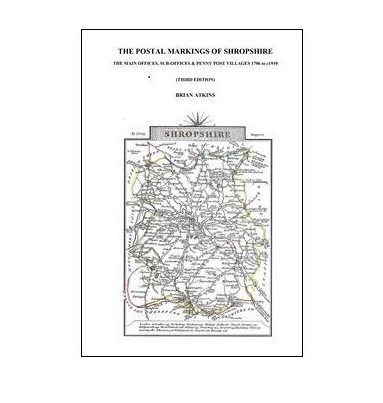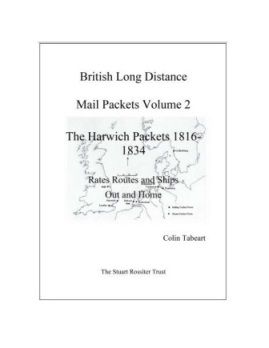General
The Stuart Rossiter Trust Fund is a Charitable Trust providing financial and other support for research and publications relating to the history of communication through postal systems of the world. Stuart Rossiter was a leading postal historian of his day. This charity was set up with money from his estate to fulfil his intention of promoting research into postal history, both past and present, and the publication of the useful results of such research.
Anyone wishing to engage on a project within the objects of the Charity, and who needs financial support or advice from Trustees experienced in helping people to prepare scripts for publication to an academic standard with the help of referees, should get in touch with the Corresponding Trustee in the first instance. Contact details can be found on the Trust’s web site www.rossitertrust.com
Applicants can be amateurs or professionals; provided the research is original, is approved and the publication is for the benefit of a wider public, adding to information publicly available.
These Author Guidelines
These guidelines are designed to help those who wish to write and publish their work with the Trusts help.
They are designed to assist rather than be proscriptive but give an indication of the standards used by the Trustees to ensure a quality result.
First Submission to the Rossiter Trust
The author is encouraged at an early stage to supply the Trustees with excerpts from the proposed work. This should include the contents page, an indication of the likely number of pages of each chapter or section, a specimen chapter of text and samples of illustrations.
The Trustees will consider such a proposal and indicate whether it is a suitable subject for publication by the Trust. Trustees are happy to offer help and advice at this and all later stages.
Manuscripts must be written in English, unless the Trustees have agreed otherwise in advance. The text of articles can be produced in any form, however the following is preferred for preparatory excerpts:
- in a Microsoft Word document attached to an email or
- in any other Windows compatible format, saved as a pdf file and attached to an email.
The near final and final texts must be submitted in digital form.
Initially, text and illustrations should be kept separate. No attempt at pagination should be made in the first instance, other than for estimates of overall length.
Referees
The Trust will appoint two referees, a Special referee and a General referee. The Special referee who is a specialist on the subject of the proposed publication will most probably be nominated by the author, and approved by the Trustees. The General referee is an all-round philatelist or postal historian who will take a general over-view of the work, but is not required to have a detailed knowledge of the subject. Both referees submit detailed comments to the Trustees. When the Special referee has read the work he will particularly advise the author on any anomalies found in the text, incorrect statements, or bring some new research of which the author may not be aware, and suggest improvements to the content.
Authors Agreement with the Trust
There is a standard author’s agreement which is tailored to suit each author.
The number of copies to be produced is agreed between the author and the Trustees and is dependent upon the subject. It is the policy of the Trust to allocate to the author five gratis copies of their work. The Trust undertakes the despatching of all the mandatory legal filing in the UK and other free and review copies.
Style Guidelines
General
Consistency is key. It may sound obvious but the look and feel of the text makes a difference as to how a book is perceived, bought and used by readers, as reference to other major postal history publications will show.
Font and type size
The body of the text should be printed on a modern computer in 11 point in Times New Roman. An alternative font is Garamond or other classic fonts.
Sans serif fonts can be difficult to read but can be used for captions.
Most computers and printers have used Times New Roman or Garamond (but modern ones may be Calibri, a sans serif font). Keep to a straightforward page arrangement, leaving all formatting to the very last stage, not a penultimate stage when text may still be inserted.
The first word of the initial paragraph of a chapter is not indented. The first word of a sentence is always spelled out, never abbreviated.
Title
Choose a precise and accurate title. It should be short and relevant.
Potential buyers of the book must be able to identify the work and recognise that the title is of relevance to their enquiry.
Front and back covers
The cover illustration will be one eye-catching piece of (preferably) postal history, with the caption below the illustration. The back cover can also be used for one or two illustrations so that a blank page is not wasted.
Abbreviations
Readers will not necessarily have the overall or detailed knowledge of the author. So, on the first occasion where the name or title to be abbreviated is used, state the full name or description and insert after that in brackets the abbreviation to be used, thus:
Peninsular & Oriental Steam Navigation Company (P & O).
Once adopted, maintain absolute consistency of lettering and punctuation throughout the text. Where many abbreviations to be used, it may be worthwhile adding to the prelim pages (see Production Guidelines) one or more pages of abbreviations with the full names and descriptions.
Numbers
Numbers from one to ten should be written out as words (one, two, three etc.). Above ten they should be numerals (11, 12, 13 etc., then with commas in 1,000 and 1,000,000). Any quotation, however, must retain the original form.
Dates
The English style of dates should be used in the text, i.e. day/month/year, preferably as in
25 January 2017 – but again any quotation must keep the original form. Abbreviated versions can be used in tables or when referring to datestamps.
Footnotes/Endnotes
Footnotes or endnotes should be for references, or sources, only, with no additional text (which, if important, should be incorporated within the main body of the text, and if not important should be omitted). They can appear as footnotes at the bottom of the relevant page, at the end of the particular chapter, or grouped by chapter or section at the end of the book.
Quotations from other sources
All quotations must replicate exactly what was in the original. Anything omitted should be indicated. Use double quote-marks for short quotations: He said “Be consistent.” The use of single quote-marks can lead to confusion with apostrophes. If the quotation itself includes another quotation, use single quote-marks inside double ones. “The paragraph above read ‘He said, Be consistent'”.
If using more than a couple of lines of quoted material from other works, one of the most satisfactory ways of delineating the quote is to indent both the left and right hand margins.
References in the text are denoted by number (in Arabic numerals) thus:
They made no special efforts to maintain their contracts. In spite of decreased manufacturing costs they continued to put in the same prices, thereby making colossal profits. They behaved as if the contracts were a foregone conclusion, and theirs by right.1
Houseman, Lorna The House that Thomas Built “ The Story of De La Rue 1968 p. 142
References to books
All references are designed for information retrieval by the reader and should be simple, clear and consistent. The author’s name should be as in the original publication, but surname first, followed by first name(s) or initials. The title of the book should be in italics followed by the date of publication and the page(s) referred to. There is normally no need for the inclusion of publishers’ names, place of publication or ISBN numbers unless different versions have to be distinguished. Examples are:
Rose, Kenneth King George V 1983, p. 158
Easton, John Postage Stamps in the Making 1949 p. 111
Samuel, Herbert [Viscount Samuel] Memoirs 1945, p. 77
A few words may amplify the reference:
For more details see
Kearsley, Bryan Discovering Seahorses: King George V High Values, 2005 p. 15
Quoted in Beaumont, K.M. & Easton, J. The Postage Stamps of Great Britain: Part Three 1964 pp. 190-1
References to periodicals
Authors names are as above. The title of the article should be within double quotation marks, followed by the name of the journal in italics, and details of volume, number, page and date in Roman type.
Richmond, R. W. The Letterpress Printed Postage Stamps of K.G.V. GB Journal Vol. 12, pp. 113-4 [1974]
Mackay, James A. The Harrison Collection of Proofs Stamp Collecting 31 January 1964, reprinted in The Essay-Proof Journal Vol. 21, No.4 1964, pp. 147-152
References to papers in archives
Here the precise catalogue reference of the file should be given, followed by an indication of where the item such as letters or memos can be found within that file, and any relevant details.
RA PS/PSO/GV/PS/STAMPS/4130/53 Bigge to Samuel 1 October 1910
MINT 14/53 Stamp Dies letters and papers, Atterbury to Rigg 20 September 1912
In these cases, the source of the files should be explained elsewhere, possibly in the bibliography:
RA = Royal Archives, Windsor
MINT is the class of files at The National Archives, Kew for the Royal Mint.
References to websites
Where possible, references to websites should include information in the same format for printed sources (author, title, page etc.) The website address should be inserted within angle brackets (< >):
Wilkinson, L. Wartime Printing Ink Problems <http://www.les-wilkinson.co.uk/article5.shtml> [accessed 3 March 2017]
The protocol prefix http:// must be retained as other protocols exist. Where the information is given include the date the information was originally created, and/or the date you accessed the site.
Bibliography
Other essential components are a list of references and a bibliography. Listing should be alphabetical in the format as above.
Index to the Work
A good index is normally essential. The production of an index can be done using appropriate computer software, or manually. It is the last task to do before final proof-reading of text. Unless numerical references under a single entry in an index are very long, the index should be set in two columns in a smaller typeface than the body of the text.
Production Guidelines
Preliminary pages (called Prelims)
A sequence of prelims is set out below.
Left-hand page
ii blank (sometimes used for a Frontispiece illustration)
iv Reverse title-page
vi blank
viii Contents [cont.]
x Foreword [cont.]
xii Preface & Acknowledgements [cont.]
Right-hand page
i Half-title
iii Title-page
v Dedication
vii Contents [Chapter headings with their pagination.]
ix Foreword
xi Preface & Acknowledgements
NB: This makes a total of 12 pages in multiples of four. These preliminary pages can be condensed or expanded depending on what is needed for each specific book. In addition there may be up to four pages of text supplied by the Trust about itself and its work.
Next should be the first page of Chapter 1 or the first page of an Introduction, beginning on the right-hand side. If this means that a white blank page arises, it is best to alter the prelims to avoid this, possibly inserting an illustration as a Frontispiece
Dedication
Where a dedication is to be included, it is usually placed on a page after the verso of the title page that is on the right side after the page behind the title page. The overall pagination of the prelims can be easily finalised once the work is nearing completion.
ISBN (International Standard Book Number)
An ISBN number (13 digits from 1.1.2007) will be allocated at the appropriate time by the Trust. This is almost the last thing to do as the books should be allocated numbers in sequential order of printing for the publisher, the Trust.
ISBN CIP (Catalogue in Publication) Form
Inclusion of ISBN CIP is an essential, as the book is then on Nielson Book Data (formerly Whitaker Information Services) who are the UK authority on books in print and issue the sequences of ISBN numbers. Neilson issue an extensive and comprehensive listing of all books in print, a listing of which booksellers generally have a copy. The Trust will complete the CIP form and this will be sent to the Author to fill in any blanks if necessary shortly after publication.
Copyright
The author of each book or article retains the copyright. If a reprint is proposed of a significant portion or all text or illustrations, diagrams, tables, graphs or maps from a work published by the Trust, prior permission must be obtained from the Trustees. Normally, permission would not be unreasonably withheld once stocks of the work have been sold by the Trust, or after three years have elapsed following the date of publication.
It is the responsibility of the authors to ensure that they have obtained permission to include in their work any illustrations, diagrams, text, maps, charts, lithographs, prints, auction catalogue illustrations that are subject to an earlier copyright and any excerpts of other copyrighted material or subject to Crown copyright, and that appropriate acknowledgement of the sources is included in the work. This is most important as the use of non-authorised material can become a matter of dispute.
Acknowledgement must be made for each item, either under the relevant item or in the “Acknowledgements” in the preliminary pages. If using other collector’s items, their permission should be obtained, and they should be asked whether they want their names specifically mentioned as being the owner of the item, or just in the general Acknowledgements, or not at all.
At present (2017) unless otherwise assigned, copyright generally (but not always) resides with the author or creator of a work for 70 years after his or her death. Crown copyright is different, being 50 years after the creation or publication of the material.
Where efforts to identify or contact the copyright holder have failed, an appropriate disclaimer must be included. In such a case the Trust should be consulted. An example of disclaimer might be expressed as follows:
Although every effort has been made to trace and contact copyright holders this has not been possible in some cases. If notified, the publisher will be pleased to rectify any errors or omissions at the earliest opportunity.
Where it is agreed with the Trustees that the author retains the copyright in the work to be published by the Trust, a statement such as this should be included on the verso of the title page to the work.
Copyright © [insert author’s names] who is identified as the author of this work [insert year of publication]
Apart from any fair dealing for the purposes of research or private study or criticism or review, no part of this publication may be reproduced, stored in a retrieval system, or transmitted in any form or by any means electronic, mechanical, photocopying or otherwise, without the prior written permission of the publishers and copyright holder.
Page Layout and Printers
The size and format of the page may be decided by the Trustees but the printer will add the necessary guillotine markings, etc., and other print instructions to suit that firm’s machinery. Comparative quotations will be obtained by the Trustees from which they will decide which printer is to do the job. It is usual for page numbering to begin on the right side when viewing a finished book lying open flat on a table. That means that odd number pages are on the right and even numbered pages are on the left. Please set your defaults to justified margins on both sides, i.e. line ends align with a uniform right-hand edge.
Pagination or Page Numbering
Preliminary pages and any pages after the main body of the text should be numbered using Roman numerals, i, ii, iii, etc. Page numbers in the body of the text will be set in Arabic numerals, 1, 2, 3, etc. They may be set in the centre of the foot of the page or to one side, in which case they should appear at the foot of the outer margin.
Running Headers
These are the page headings if felt necessary. If used, they should not appear on the first page of a chapter or in the prelims.
Illustrations
All images should be scanned at 300dpi and saved as TIFF files (.tif) or good quality Jpegs (.jpeg). Images should not be compressed and then re-expanded. If in doubt, contact the Trustees in advance.
Once an illustration has been inserted in this format into the text, a “frame” showing “handles” can be selected by which the size of the image can be altered to fit the page format. Not too much work should be done by the author without consultation with the Trustees who will guide the author on this, depending upon the quantity of illustrations.
Format
The format adopted for the publication will be chosen to suit the work and its content. The paper will be of a suitable weight and should aim to fulfil, if it does not actually conform to, the international archival standard ISO 9706 represented by an infinity sign (∞). The quality of paper used will also be chosen to make sure that the best impressions can be obtained of illustrations included.
Margins
Whether the work is produced in UK A4 format or US letter size, adequate margins must be allowed for, about 2-3cm, to allow also for binding and for thumbing by readers. Similarly, space must be allowed for at top of the page for the running heads, i.e. short title of the work and indication of what each section of the work is about, and page numbers at the foot.
Final Text Print Out
The text must be “proof-read” in its final form before it is given to the printers for printing. If the final editorial work is done by the printers a single proof is usually provided, otherwise successive proofs can be prohibitively expensive. It is paramount that this final proof read is carried out with the utmost care. Making corrections once the text is at the printer is prohibitively expensive, and every “key-stroke” is charged for. Should the Trust find that many authors errors arise at this late stage, the cost of making corrections may be recovered from the author before the work is printed. It is very helpful if the printers are supplied with a correct mock-up of the text showing the correct sequence of pages, even if done as a rough paste-up. This may save page collation mistakes later.




